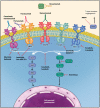Molecular targeted therapies in advanced gastric cancer: does tumor histology matter?
- PMID: 23320047
- PMCID: PMC3539290
- DOI: 10.1177/1756283X12453636
Molecular targeted therapies in advanced gastric cancer: does tumor histology matter?
Abstract
It is increasingly recognized that gastric cancer is a heterogeneous disease which may be divided into subgroups based on histological, anatomical, epidemiological and molecular classifications. Distinct molecular drivers and tumor biology, and thus different treatment targets and predictive biomarkers, may be implicated in each subtype. However, there is little evidence in the literature regarding the correlation among these different classifications, and particularly the molecular aberrations present in each subtype. In this review, we approach advanced gastric cancer (AGC) by presenting aberrant molecular pathways and their potential therapeutic targets in gastric cancer according to histological and anatomical classification, dividing gastric cancer into proximal nondiffuse, distal nondiffuse and diffuse disease. Several pathways are involved predominantly, although not exclusively, in different subtypes. This may help to explain the disappointing results of many published AGC trials in which study populations were heterogeneous regardless of clinicopathological characteristics of the primary tumor. Histological and anatomical classification may provide insights into tumor biology and facilitate selection of an enriched patient population for targeted agents in future studies and in the clinic. However, some molecular pathways implicated in gastric cancer have not been studied in correlation with histological or anatomical subtypes. Further studies are necessary to confirm the suggestion that such classification may predict tumor biology and facilitate selection of an enriched patient population for targeted agents in future studies and in the clinic.
Keywords: Advanced gastric cancer; angiogenic pathway; biomarker; epidermal growth factor pathway; targeted therapy.
Conflict of interest statement
Figures


Similar articles
-
Reproduction of the Cancer Genome Atlas (TCGA) and Asian Cancer Research Group (ACRG) Gastric Cancer Molecular Classifications and Their Association with Clinicopathological Characteristics and Overall Survival in Moroccan Patients.Dis Markers. 2021 Jul 28;2021:9980410. doi: 10.1155/2021/9980410. eCollection 2021. Dis Markers. 2021. PMID: 34367379 Free PMC article.
-
Gastric cancer molecular classification based on immunohistochemistry and in situ hybridization: Analysis in western patients after curative-intent surgery.World J Clin Oncol. 2021 Aug 24;12(8):688-701. doi: 10.5306/wjco.v12.i8.688. World J Clin Oncol. 2021. PMID: 34513602 Free PMC article.
-
Targeted therapy in the management of advanced gastric cancer: are we making progress in the era of personalized medicine?Oncologist. 2012;17(3):346-58. doi: 10.1634/theoncologist.2011-0311. Epub 2012 Feb 14. Oncologist. 2012. PMID: 22334453 Free PMC article.
-
Novel targets in the treatment of advanced gastric cancer: a perspective review.Ther Adv Med Oncol. 2016 Mar;8(2):113-25. doi: 10.1177/1758834015616935. Ther Adv Med Oncol. 2016. PMID: 26929787 Free PMC article. Review.
-
Molecular classifications of gastric cancers: Novel insights and possible future applications.World J Gastrointest Oncol. 2017 May 15;9(5):194-208. doi: 10.4251/wjgo.v9.i5.194. World J Gastrointest Oncol. 2017. PMID: 28567184 Free PMC article. Review.
Cited by
-
Molecular classification of gastric cancer: Towards a pathway-driven targeted therapy.Oncotarget. 2015 Sep 22;6(28):24750-79. doi: 10.18632/oncotarget.4990. Oncotarget. 2015. PMID: 26267324 Free PMC article. Review.
-
PI3K/AKT/β-Catenin Signaling Regulates Vestigial-Like 1 Which Predicts Poor Prognosis and Enhances Malignant Phenotype in Gastric Cancer.Cancers (Basel). 2019 Dec 3;11(12):1923. doi: 10.3390/cancers11121923. Cancers (Basel). 2019. PMID: 31816819 Free PMC article.
-
Investigation on the cellular mechanism of Prunetin evidenced through next generation sequencing and bioinformatic approaches against gastric cancer.Sci Rep. 2022 Jul 13;12(1):11852. doi: 10.1038/s41598-022-15826-y. Sci Rep. 2022. PMID: 35831348 Free PMC article.
-
The role of antiangiogenic agents in the treatment of gastric cancer: A systematic review and meta-analysis.Medicine (Baltimore). 2017 Mar;96(10):e6301. doi: 10.1097/MD.0000000000006301. Medicine (Baltimore). 2017. PMID: 28272258 Free PMC article.
-
Receptor tyrosine kinase amplified gastric cancer: Clinicopathologic characteristics and proposed screening algorithm.Oncotarget. 2016 Nov 1;7(44):72099-72112. doi: 10.18632/oncotarget.12291. Oncotarget. 2016. PMID: 27765925 Free PMC article.
References
-
- Al-Kasspooles M., Moore J., Orringer M., Beer D. (1993) Amplification and over-expression of the EGFR and erbB-2 genes in human esophageal adenocarcinomas. Int J Cancer 54: 213–219 - PubMed
-
- Alsina M., Ko A., Garcia De Paredes M., Rivera F., Schwartzberg L., Fattaey A., et al. (2011) Clinical and pharmacodynamic (PD) results of TEL0805 trial: a phase II study of telatinib (TEL) in combination with capecitabine (X) and cisplatin (P) as first-line treatment in patients (pts) with advanced gastric or gastroesophageal junction (GEJ) cancer. J Clin Oncol 29(Suppl.): abstract 4122
-
- An J., Kim K., Choi M., Noh J., Sohn T., Bae J., et al. (2010) Prognostic role of p-mTOR expression in cancer tissues and metastatic lymph nodes in pT2b gastric cancer. Int J Cancer 126: 2904–2913 - PubMed
-
- Asaka M., Kimura T., Kato M., Kudo M., Miki K., Ogoshi K., et al. (1994) Possible role of Helicobacter pylori infection in early gastric cancer development. Cancer 73: 2691–2694 - PubMed
-
- Bang Y., Chung H., Xu J., Lordick F., Sawaki A., Lipatov O., et al. (2009) Pathological features of advanced gastric cancer (GC): relationship to human epidermal growth factor receptor 2 (HER2) positivity in the global screening programme of the ToGA trial. J Clin Oncol 27(15 Suppl.): abstract 4556
LinkOut - more resources
Full Text Sources

